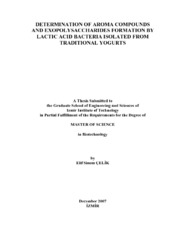Please use this identifier to cite or link to this item:
https://hdl.handle.net/11147/3865Full metadata record
| DC Field | Value | Language |
|---|---|---|
| dc.contributor.advisor | Korel, Figen | en |
| dc.contributor.author | Çelik, Elif Sinem | - |
| dc.date.accessioned | 2014-07-22T13:52:32Z | - |
| dc.date.available | 2014-07-22T13:52:32Z | - |
| dc.date.issued | 2007 | en |
| dc.identifier.uri | http://hdl.handle.net/11147/3865 | - |
| dc.description | Thesis (Master)--Izmir Institute of Technology, Biotechnology, Izmir, 2007 | en |
| dc.description | Includes bibliographical references (leaves: 86-94) | en |
| dc.description | Text in English; Abstract: Turkish and English | en |
| dc.description | xii, 99 leaves | en |
| dc.description.abstract | Yogurt, consumed widely around the world, is a fermented milk product as a result of the lactic acid fermentation by addition of starter cultures containing Streptococcus thermophilus and Lactobacillus delbrueckii ssp. bulgaricus. The most important criteria for yogurt production is the selection of starter cultures since each culture affects the end-product quality differently. Our natural flora and traditional flavor have been continously changing due to the introduction of imported commercial starter cultures. Because of the necessity to preserve our natural starter cultures and to increase the availability of them for industrial use, these cultures must be isolated from artisanal yogurts, genetically characterized and investigated regarding their technological properties. Aims of our study were to determine the technological and organoleptic properties of starter cultures previously isolated and genetically characterized and to assess the feasibility of near-infrared (NIR) spectroscopy for determining the yogurt quality.Total of 20 different yogurt samples were produced using combinations of 5 Streptococcus thermophilus and 4 Lactobacillus delbrueckii ssp. bulgaricus strains. Yogurt samples were stored at 4 °C for 21 days. Chemical, physical, microbial and organoleptic analyses for samples were conducted at predetermined days.As a conclusion, it was found that 4 Streptococcus thermophilus and 4 Lactobacillus delbrueckii ssp. bulgaricus yogurt isolates have potential to be used in dairy industry regarding their high technological and organoleptic characteristics. In addition, NIR spectroscopy technique could be used successfully on yogurt samples to predict total solids, fat, pH, syneresis, and microbial counts of yogurts based on the calibration models (Genetic Algoritm). | en |
| dc.language.iso | en | en_US |
| dc.publisher | Izmir Institute of Technology | en |
| dc.rights | info:eu-repo/semantics/openAccess | en_US |
| dc.subject.lcc | SF275.Y6 C3928 2007 | en |
| dc.subject.lcsh | Yogurt | en |
| dc.subject.lcsh | Fermentation | en |
| dc.subject.lcsh | Bacterial starter cultures | en |
| dc.subject.lcsh | Dairy products industry | en |
| dc.title | Determination of aroma compounds and exopolysaccharides formation by lactic acid bacteri isolated from traditional yogurts | en_US |
| dc.type | Master Thesis | en_US |
| dc.institutionauthor | Çelik, Elif Sinem | - |
| dc.department | Thesis (Master)--İzmir Institute of Technology, Bioengineering | en_US |
| dc.relation.publicationcategory | Tez | en_US |
| item.languageiso639-1 | en | - |
| item.openairecristype | http://purl.org/coar/resource_type/c_18cf | - |
| item.fulltext | With Fulltext | - |
| item.grantfulltext | open | - |
| item.cerifentitytype | Publications | - |
| item.openairetype | Master Thesis | - |
| Appears in Collections: | Master Degree / Yüksek Lisans Tezleri | |
Files in This Item:
| File | Description | Size | Format | |
|---|---|---|---|---|
| T000696.pdf | MasterThesis | 850.8 kB | Adobe PDF |  View/Open |
CORE Recommender
Page view(s)
232
checked on Sep 30, 2024
Download(s)
402
checked on Sep 30, 2024
Google ScholarTM
Check
Items in GCRIS Repository are protected by copyright, with all rights reserved, unless otherwise indicated.